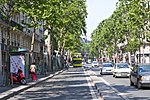Saint-Sulpice, Paris
1646 establishments in France19th-century Roman Catholic church buildings in FranceBuildings containing meridian linesBurial sites of the House of la Tour d'AuvergneBurials at Saint-Sulpice, Paris ... and 3 more
Harv and Sfn no-target errorsRoman Catholic churches completed in 1870Roman Catholic churches in the 6th arrondissement of Paris

The Church of Saint-Sulpice (French pronunciation: [sɛ̃sylpis]) is a Roman Catholic church in Paris, France, on the east side of Place Saint-Sulpice, in the Latin Quarter of the 6th arrondissement. It is only slightly smaller than Notre-Dame and thus the second-largest church in the city. It is dedicated to Sulpitius the Pious. Construction of the present building, the second church on the site, began in 1646. During the 18th century, an elaborate gnomon, the Gnomon of Saint-Sulpice, was constructed in the church.
Excerpt from the Wikipedia article Saint-Sulpice, Paris (License: CC BY-SA 3.0, Authors, Images).Saint-Sulpice, Paris
Rue Palatine, Paris Quartier de l'Odéon (Paris)
Geographical coordinates (GPS) Address Website External links Nearby Places Show on map
Geographical coordinates (GPS)
| Latitude | Longitude |
|---|---|
| N 48.851111111111 ° | E 2.3347222222222 ° |
Address
Église Saint-Sulpice
Rue Palatine 2
75006 Paris, Quartier de l'Odéon (Paris)
Ile-de-France, France
Open on Google Maps











